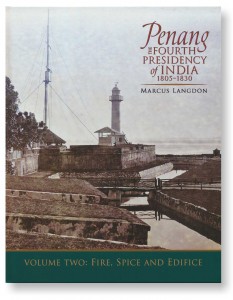12 Sept 2015: Fourth Presidency of India Vol. 2 September 25, 2015 – Posted in: Newsletters
 Gorgeously illustrated with rare paintings, sketches, engravings and maps, ‘Fire, Spice & Edifice is the next authoritative reference for historians and general readers. Its ultimate aim as a rich historical resource is equalled only by its predecessor, Ships, Men and Mansions.
Gorgeously illustrated with rare paintings, sketches, engravings and maps, ‘Fire, Spice & Edifice is the next authoritative reference for historians and general readers. Its ultimate aim as a rich historical resource is equalled only by its predecessor, Ships, Men and Mansions.
Subtitled Fire, Spice and Edifice, Marcus Langdon’s sequel to Penang, The Fourth Presidency of India 1805-1830: Ships, Men and Mansions continues the saga of the British East India Company’s administration of Penang up until the cessation of the China trade in 1834. While the first volume focussed on shipbuilding, leading political personalities and two historic buildings, the second volume delves into the development of some of Penang’s major structures and institutions, and the roles played by the forces of nature—sea and fire—in the evolution of George Town. Although it lasted only 25 years, the ‘presidency’ was indeed a watershed period in Penang’s history.
This new volume is divided into seven books, each dealing with an individual topic: Book One examines Penang’s most significant and iconic building, Fort Cornwallis. Book Two looks at the influence fire had on the development of George Town. Book Three details the establishment and running of the Penang Free School in its formative years. Book Four examines why the Protestants were the last to construct a dedicated place of worship—St George’s Church. Book Five deals with the establishment of the first two spice and botanic gardens, and how Penang helped end the Dutch monopoly in nutmeg and clove. Book Six discusses the origins of the Penang Public Library and Book Seven looks at the problems caused by constant erosion of the northern beachfront and the numerous efforts to control it. It suffices to say that this new volume is designed primarily as a useful, reliable and enduring research guide, written in a highly readable style which will appeal to the serious or casual historian, researcher or scholar. It is worth noting that some of the passages reproduced in this volume have been painstakingly transcribed from handwritten originals.
Gorgeously illustrated with paintings, sketches, engravings and maps—many previously unpublished—this series will be the authoritative reference for historians and general readers for generations to come. Its ultimate aim as a rich resource—to both better understand the people, processes and activities which led to the successful establishment of George Town, and the challenge to preserve its uniqueness in the face of rapid evolvement—is unparalleled.
“Marcus Langdon’s in-depth study of Penang’s settlement by the EIC provides an enduring and invaluable resource. His painstaking and assiduous research is a scholarly tour de force that helps to bring to life the personalities who enabled the British to use Penang as their first military redoubt to eventually hold sway over the entire Malay peninsula.” —YAB Lim Guan Eng, Chief Minister of Penang
